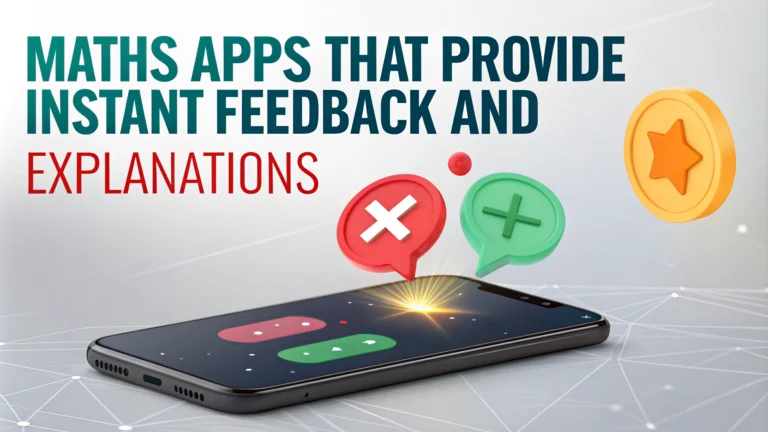Math apps with instant feedback and explanations can transform learning for kids and teens. These tools offer personalized guidance, making math more engaging and less intimidating. Let’s explore how these apps can boost math skills and confidence.
Key Features of Effective Math Apps
The best math apps combine several essential features:
- Real-time feedback: Immediate responses to answers
- Step-by-step explanations: Clear breakdown of problem-solving processes
- Adaptive learning: Customized content based on user performance
- Gamification: Fun elements to increase engagement
- Progress tracking: Visual representation of improvement
These features work together to create a dynamic learning environment that adapts to each student’s needs.
Benefits of Instant Feedback in Math Learning
Instant feedback in math apps offers numerous advantages:
- Immediate error correction: Prevents reinforcement of misconceptions
- Increased motivation: Quick wins boost confidence
- Efficient learning: Faster identification of weak areas
- Self-paced progress: Students can move at their own speed
This immediate response system helps students stay engaged and focused on improvement.
Selecting the Right Math App for Your Needs
Consider these factors when choosing a math app:
- Age appropriateness: Ensure content matches the student’s grade level
- Topic coverage: Check if the app covers required math subjects
- Learning style compatibility: Look for apps that align with preferred learning methods
- Device compatibility: Verify the app works on available devices
- User interface: Choose apps with intuitive, easy-to-navigate designs
Take advantage of free trials to test different apps before committing to one.
Recommended Math Apps by Age Group
| Age Group | Recommended Apps |
|---|---|
| 5-8 years | Prodigy, Splash Math |
| 9-12 years | Khan Academy Kids, IXL Math |
| 13-18 years | Photomath, Mathway |
These apps cater to different learning stages and offer a range of features to support math skill development.
Maximizing Learning with Math Apps
Math apps offer a powerful way to boost math skills and confidence. With instant feedback and personalized learning, these tools can transform how students approach math. This guide explores how to make the most of math apps for enhanced learning.
Integrating Math Apps into Daily Routines
Consistency is key when using math apps. Here’s how to make them a regular part of learning:
- Set daily goals: Aim for 15-30 minutes of app use each day
- Create a dedicated space: Designate a quiet area for focused practice
- Use reminders: Set app notifications to prompt regular sessions
- Reward progress: Celebrate milestones to maintain motivation
By making math apps a habit, students can see steady improvement over time.
Combining App Use with Traditional Learning
Math apps work best when used alongside other learning methods:
- Supplement homework: Use apps to reinforce concepts from school
- Pre-learning: Introduce new topics before classroom lessons
- Problem-solving practice: Apply app skills to real-world math problems
- Group study: Share app progress with classmates for peer motivation
This blended approach helps solidify math concepts across different learning contexts.
Monitoring Progress and Adjusting Strategies
Regular assessment ensures math apps are effective:
- Review app reports: Check built-in progress trackers weekly
- Compare with school performance: Look for improvements in grades
- Discuss with teachers: Get feedback on areas needing more focus
- Adjust difficulty levels: Increase challenge as skills improve
By staying on top of progress, you can tailor the app experience for optimal learning.
Addressing Common Challenges
Overcome obstacles to effective math app use:
- Boredom: Switch between different apps to maintain interest
- Frustration: Take breaks and return to easier levels if needed
- Overreliance: Balance app use with mental math practice
- Distractions: Use device settings to limit non-educational apps during study time
Addressing these issues helps maintain engagement and learning momentum.
Tips for Parents and Educators
| Role | Tips |
|---|---|
| Parents | – Model positive math attitudes – Engage in app activities together – Discuss math concepts in daily life |
| Educators | – Recommend apps aligned with curriculum – Use app data to inform teaching – Encourage peer support among students |
Support from adults plays a crucial role in maximizing the benefits of math apps.
Future of Math Learning with Apps
The landscape of math apps continues to evolve:
- AI-driven personalization: More tailored learning experiences
- Virtual reality integration: Immersive math problem-solving
- Cross-platform syncing: Seamless learning across devices
- Social learning features: Collaborative problem-solving with peers
Staying informed about these trends can help you choose the most effective tools for math learning.
Wrapping Up: The Power of Math Apps
Math apps with instant feedback offer a dynamic way to enhance math skills. By integrating these tools into daily routines, combining them with traditional learning, and monitoring progress, students can significantly boost their math abilities. With the right approach, math apps can transform challenges into opportunities for growth and confidence in mathematics.

